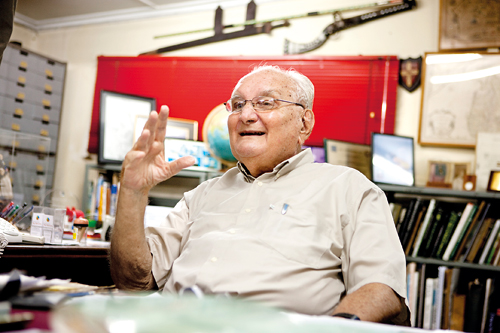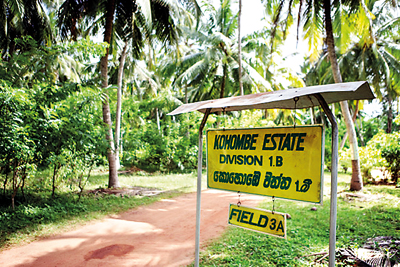With his feet firmly planted he let his vision take flight

Ray Wijewardene: A man ahead of his time. Pic courtesy Biomass Group
The one thing in Ray Wijewardene’s low-ceilinged, ship’s cabin of a study that really sucks you in is a David Attenborough poster of a magnified dragonfly- its great red eyes boring into you like intelligent pearls against the bright tropical greenery. It is a symbol of Ray’s own undying curiosity about nature. Where Wordsworth and Burton and most of us saw the beauty of nature only, Ray glimpsed the greater plan of Gaia- the way her reasoning and seam and chalk lines run.
It was this acute observation of nature and his lateral thinking (which friend Ashley de Vos says ran like the Mahaweli river everywhere- “flowing and flooding the banks and coming again”) that made him such a wonder- a thinker who would make the bamboo tats in his holiday ‘tree hut’ draw from down to up (because ‘below’ is where you need privacy)- or air-condition only his four poster bed with a fridge unit (because you really don’t want to AC your shoes as well).
His fascinating lab/study- festooned with plane models, silver-worked guns, antique maps and boomerangs- is Spartan for an eminent scion of the Tudugala Wijewardene family- austere, functional.
For Deshamanya Vidyajothi Ray Wijewardene, former Chancellor of the Moratuwa University, Cambridge-educated engineer, inventor, agriculturalist, aviator and Olympic athlete, was a man who saw beauty in the utilitarian- at its most productive.
Upul Jayalath, who took care of Ray’s 140-acre coconut estate Kohombe, recalls what must be the supreme model of sustainability.
“Each coconut tree was individually treated and each had its ‘bed ticket’- marked with what ailed the tree and the treatments done. Once cured, each ticket was daubed with ash.”

A long partnership: Ray with his wife Seela
Gliricidia (the miracle plant Ray would promote throughout his life) gave leaves as fertilizer, ensuring that Kohombe produced the highest yield of coconuts and those of the best organic quality in Sri Lanka.
Using a homemade gasifier, the gliricidia wood was used to provide electricity for 10 homes in the estate, while also powering a water pump. Yarn, made with coconut fibre, in 25 kilo rolls, was exported. All the estate’s electricity was generated using gliricidia wood- all zero input.
“He wanted our country to become self-sustained like the estate,” says Upul.
Ray’s crusade for Gliricidia went beyond agriculture, as U. D. Jayawardene, engineer, recalls.
“He realized that the only source of water we have is the rain water from the two monsoons. This precious supply is wasted when the rivers overflow and the water ends up in the sea after causing floods. His suggestion was that- in addition to forest cover- we have a 3km cover of gliricidia.
“He also knew that 90% of the country’s fuel needs could be met by Gliricidia wood alone.”
Re-greening Sri Lanka- something environmental scientists see as a key factor in the fight for global recovery today- was taken up by him 20 years ago.
One entrepreneur who carries forward his legacy of gliricidia is Lucky Dissanayake who was charmed by one of Ray’s simple ideas (as Hercule Poirot complained- they always seem simple once explained).
Using an out-grower model- without owning a single parcel of land- Lucky and her firm produce fuel wood from Gliricidia.
Over 40,000 smallholder farmers are encouraged to grow at least one fence of gliricidia around their land or intercrop, and thus provide food, fuel and livelihood development for themselves and for Biomass Group- Lucky’s company- deforestation-free, sustainable, ethical, traceable and certified fuel wood.
Today the company produces many thousands of tons of commercial biomass.
Lalith Seneviratne, Director/ Group Chief Executive Officer of Telecom and friend, recalls Ray’s peripatetic life as salesman of the Landmaster tractor he invented in the 1950s. Whereas Ray’s initial target was to sell 30 Landmasters in Japan, in the first year he ended up selling a hundred thousand in that country alone.
Behind Ray’s table is a framed caricature that delightfully accentuates Ray’s great elegance- with that very aristocratic aquiline nose. This cartoon is by Asela Samaratunga- one of the few handpicked protégés Ray mentored and today a Chartered Quantity Surveyor in the UK.
Party to Ray’s later flying escapades, Asela recalls how the sky always made the great man dream. Rowing in dreamy Giritale Lake once, he would say looking up “we are all like clouds. We appear and disappear with the time. We meet and move with the wind. Sometimes we form new clouds and it continues. It goes on and on…”
To be close to the clouds was inebriating. Asela was an assistant with Cyril the chauffeur, Mano his technical assistant and others in flying.
“Ray was a perfectionist. He’d never be satisfied until we did our jobs properly no matter how long it took. I was fortunate to fly with him in his ‘Lihiniya’ two-seater and ‘Kura’ the two-seater helicopter. All these were built by him from imported kits. Once these were built we customized them with Ray’s own preferred colour schemes and logos. I worked with him and Mano to design and paint the colour schemes for the ‘Kura’ and ‘Sutikka’ small helicopters.

A model of sustainability: Ray’s Kohombe estate
“He insisted we write the letters on the body of the helicopters in Sinhala. He always had blessings from Podi Hamuduruwo before any test flights of the home-built aircraft. Ray used to call them ‘necessary insurance policy’ for the ‘toys’. ‘Kura’ the home built twin seater helicopter crashed while Ray with Mano were heading towards Ratmalana Airport from Kakapalliya.
“Ray never gave up. He wanted to build another experimental aircraft , but this time a single seater following the instructions from his wife- ‘if you want to kill yourself- don’t kill others,’ so he went and ordered a single seater, small helicopter model called Robinson Mini 500. Investigations have found out that ‘Kura’ crashed due to a design fault in the main rotor blades.”
Practicality meant Ray was frugal and modest, his tantrum bursts cleared quickly- and he never became what many eminent Lankans became when successful- haughty parodies of themselves.
Sivam Krish, who was another protégé, has this to add:
“We, now, live in the world that Ray fantasied. Agriculture has finally become a playground for advanced technologies like AI, Robotics and Drones. Ray would have loved it. It is something he foresaw decades ago in a time when the British colonial era left Ceylon with experts in wells – doctors, engineers, agriculturalists competed but dug in. Ray floated above them all – seeing the connections they did not see – working on possibilities that they could not imagine or appreciate. His love for the environment and agriculture and aviation is now taking amazing forms – something he foresaw.
“He wanted to be re-born as a hummingbird – that could do aerial gymnastics that no flying machine can still accomplish. Every time I see one – I remember Ray.”


